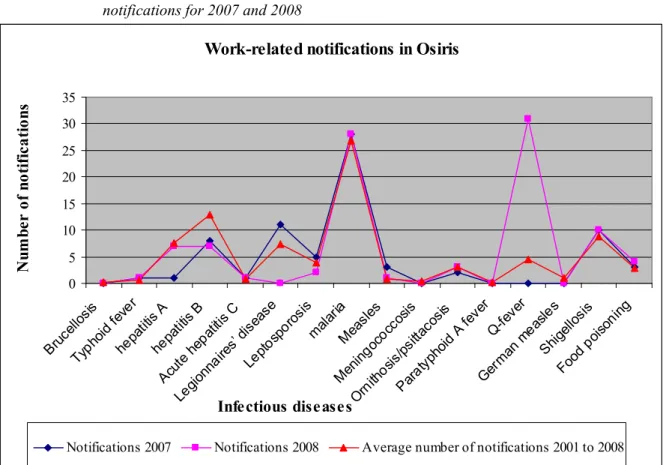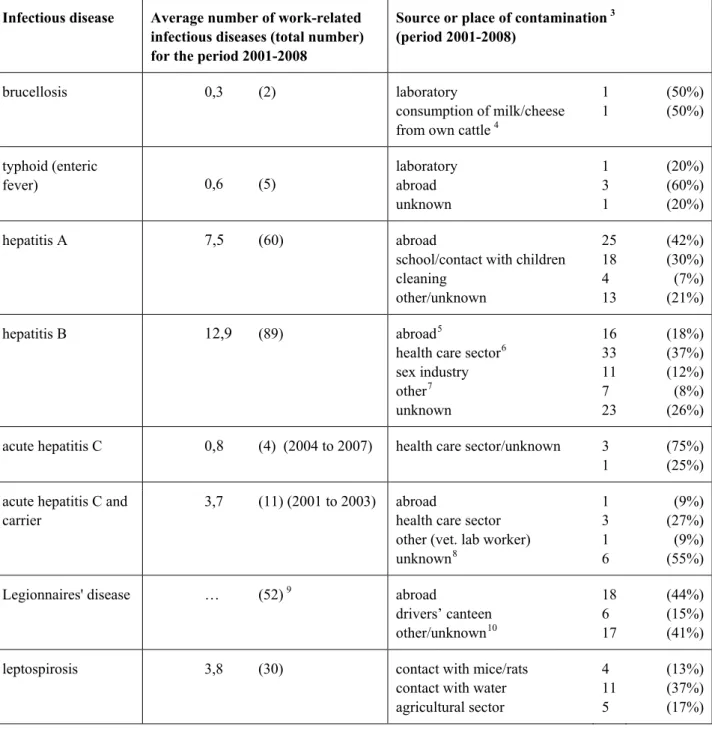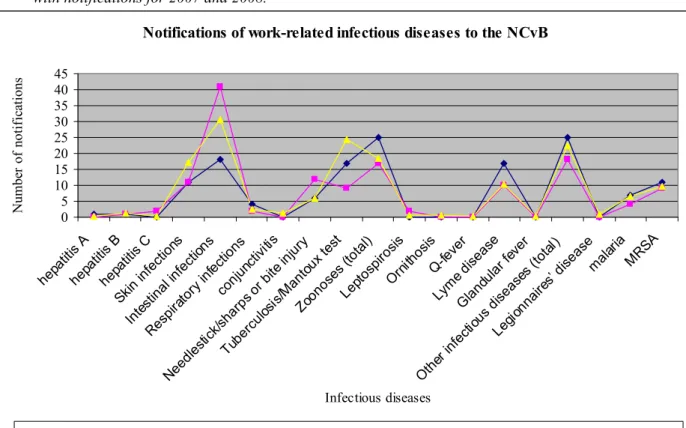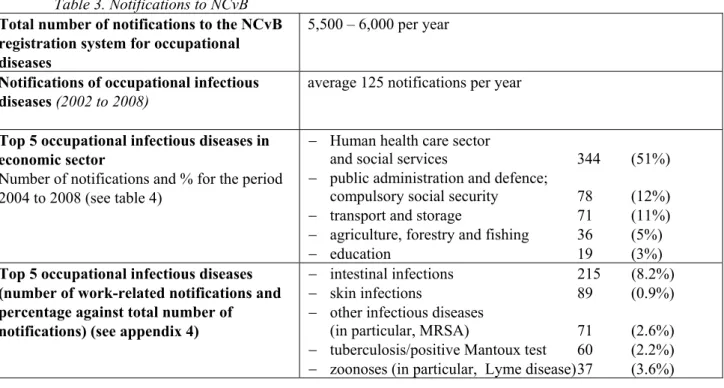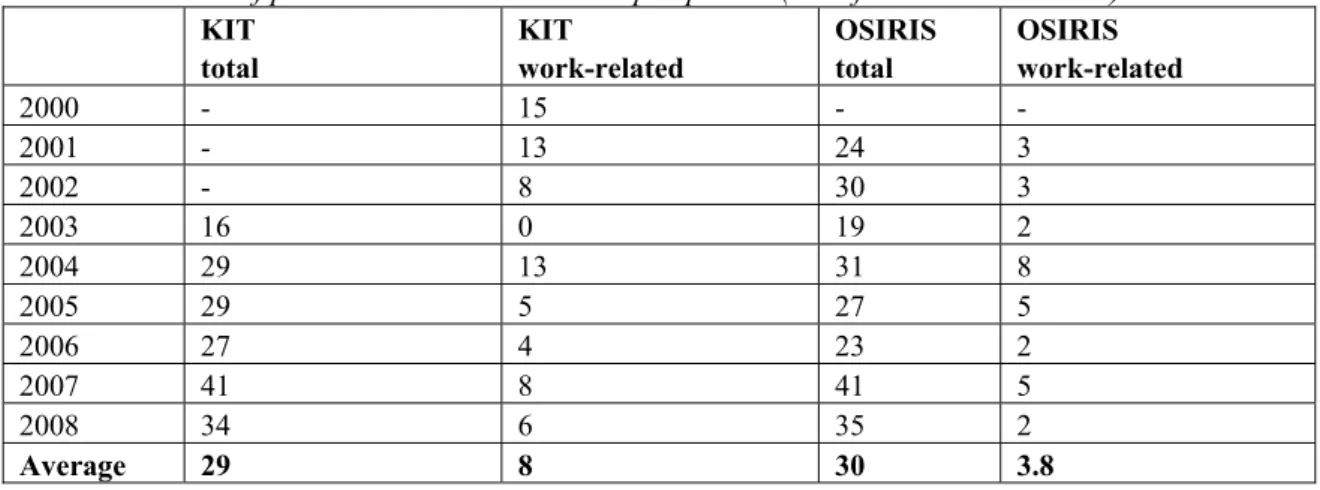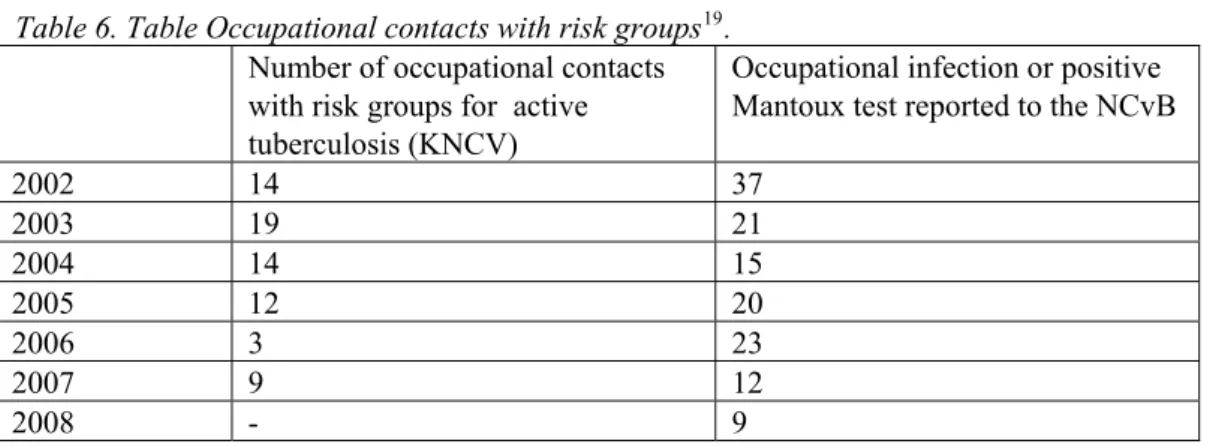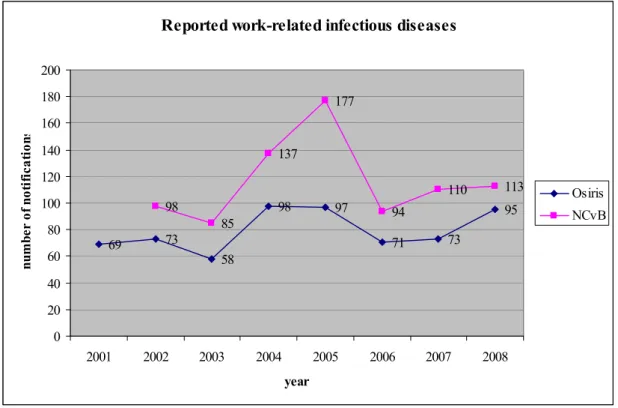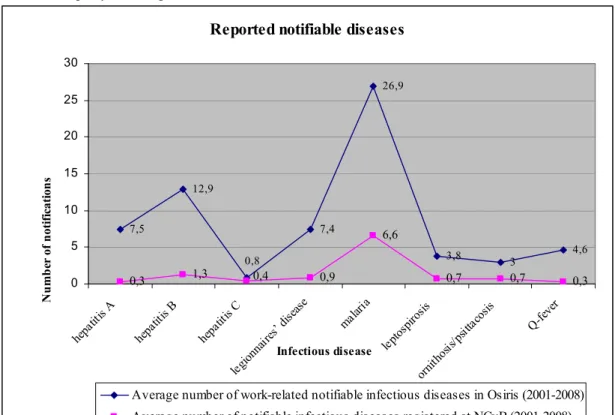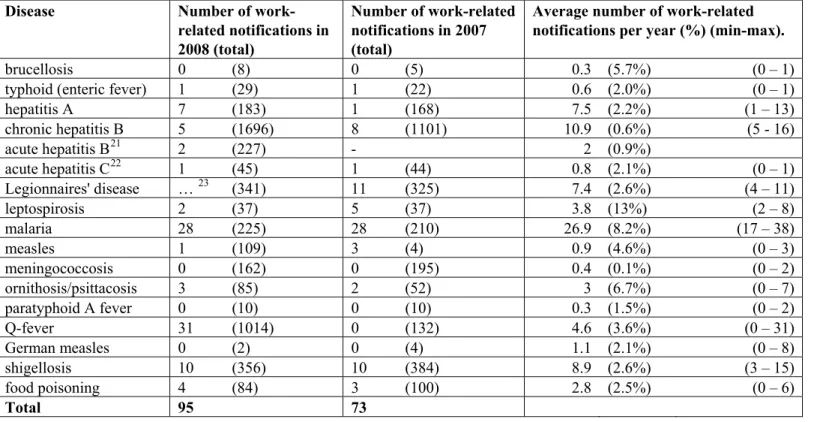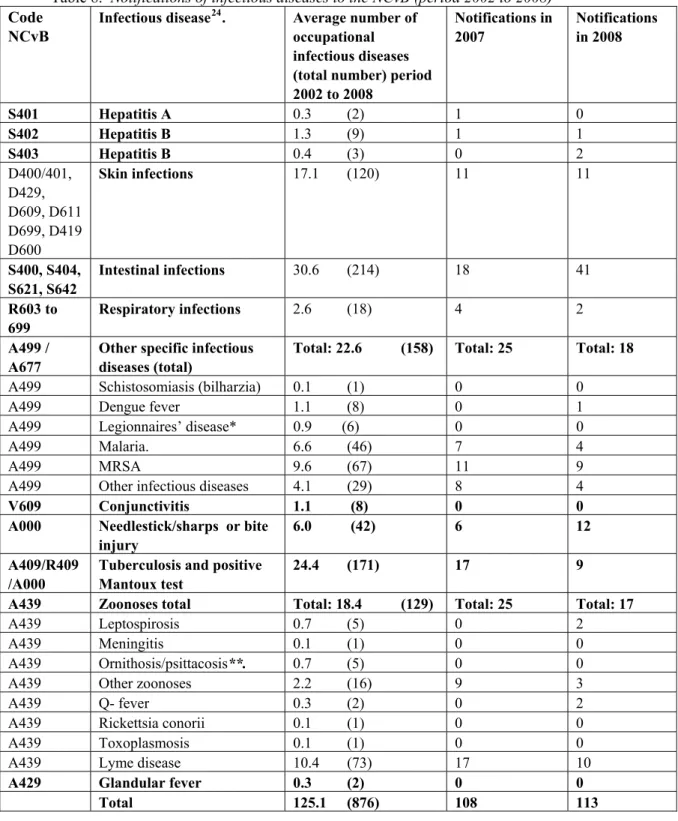Report 205014005/2009
C.T. Heimeriks | D.J.M.A. Beaujean | J. Maas
Surveillance of work-related infectious
diseases in the Netherlands 2009
RIVM- Letter report 205014005
Surveillance of work-related infectious diseases
in the Netherlands 2009
Karin Heimeriks (occupational hygienist) Desirée Beaujean (project manager) Jaap Maas (project manager)
Contact:
C.T. Heimeriks, LCI karin.heimeriks@rivm.nl
Report on the project Infectious Disease Control & Employee Health Commissioned by the Directorate for Working Conditions at the Ministry of Social Affairs and Employment
© RIVM 2009
Delen uit deze publicatie mogen worden overgenomen op voorwaarde van bronvermelding: 'Rijksinstituut voor Volksgezondheid en Milieu (RIVM), de titel van de publicatie en het jaar van uitgave'.
Table of contents
Abstract 4 1 Introduction 5 2 Osiris 6 2.1 Introduction 6 2.2 Results 63 NCvB registration system for occupational diseases 13
3.1 Introduction 13
3.2 Results 13
4 Other registration systems 17
4.1 Introduction 17
4.2 Leptospirosis notifications 17
4.3 Registrations of tuberculosis 18
5 Comparison of Osiris and NCvB registration systems 20
5.1 Results 20
6 Conclusion and recommendations 23
6.1 Conclusion 23
6.2 Recommendations 25
Appendix 1 Infectious diseases reported in Osiris 26 Appendix 2 Number of notifiable diseases 2001-2008 27 Appendix 3 Public Health Act. 29 Appendix 4 infectious diseases registered at the NCvB 30
Abstract
As commissioned by the Ministry of Social Affairs and Employment, the Centre for Infectious Disease Control (CIb) of the National Institute for Public Health and the Environment (RIVM) has analysed the two systems currently used for the registration of infectious diseases in the Netherlands – namely, the registration system for notifiable infectious diseases (Osiris) and the system for the registration of occupational diseases used by the Netherlands Center for Occupational Diseases (NCvB). Osiris and the NCvB’s registration of occupational diseases are the only registration systems that provide information on work-related infectious diseases in the Netherlands.
Osiris registers only notifiable infectious diseases, while entries in the NCvB register comprise occupational diseases reported by occupational physicians. What is evident from these two systems is that there are few notifications that match over both systems. This means that when the data from both systems is combined, there is a more complete picture of work-related infectious diseases that are contracted in the work environment.
Due to the small number of notifications and the under-reporting in both registration systems, no statistically reliable statements can be made regarding the number of employees who contract an infectious disease whilst they are at work. Analysing the data does, however, provide valuable
information on the occurrence of infectious diseases in the working environment and the kinds of tasks being carried out when exposure occurs.
Each year approximately 80 work-related cases are registered in Osiris; this is 1.2% of the total number of notifications (from the average of 6,500 registrations per year). The most commonly occurring notifiable infectious diseases contracted whilst people are at work are malaria, hepatitis B, shigella, hepatitis and Legionnaires' disease. According to Osiris data, a little more than half of the reported work-related infectious diseases were contracted during a business trip abroad. This is followed by health care, veterinary medicine and education as those sectors where the most work-related infectious diseases occur. For one quarter of the patients who have contracted an infectious disease whilst at work, the professional branch in which they are working is not known. In August 2009, Osiris was revised and some extra questions were added to the system. This revision should enable data on the profession, type of work and the professional sector of patients to be analysed in the future. The registration office of the NCvB registers an average of 5,500 to 6,000 cases per year. From this total, about 125 (2.3%) notifications concern work-related infectious diseases. The most common infectious diseases registered at the NCvB are intestinal infections, skin infections, other infectious diseases (in particular MRSA), tuberculosis or a positive Mantoux test and zoonoses – particularly Lyme disease). Half of the infectious diseases reported to the NCvB have been contracted whilst people were working in the health care sector. These notifications are mainly related to intestinal infections, skin infections, and tuberculosis or a positive Mantoux test.
1
Introduction
As commissioned by the Ministry of Social Affairs and Employment, the Centre for Infectious Disease Control (CIb) at the RIVM has examined whether the registration of notifiable infectious diseases in Osiris is a valuable supplement to the registration of occupational diseases in the register of the Netherlands Center for Occupational Diseases (NCvB). From the previous report (2007) it is clear that both registration systems provide information on the occurrence of work-related infectious diseases in the Netherlands but that both systems register different infectious diseases. The registrations have negligible overlap.
However, an analysis of the data from both systems and the combination of the two sets of data provides a much more complete picture of work-related infectious diseases that are contracted whilst a person is at work.
In the Netherlands, very little is known about the number of work-related infectious diseases that occur. By analysing the registrations, some insight can be gained into the kind of work that is being carried out when the work-related infectious disease is contracted. The actual number of infectious diseases that occurs in the workplace is not known due to under-reporting in both of the systems used.
The objective of this report is to provide an overview of which and how many work-related infectious diseases are registered in the NCvB system for occupational diseases and the RIVM/CIb (Osiris) system for notifiable infectious diseases.
A considerable proportion of the working population – between six and eight million employees - is exposed to occupational risks. Many of these employees may be exposed to infectious diseases, for example, whilst working in the health care sector, during business trips abroad, through contact with animals and/or working in a laboratory.
The registered work-related infectious diseases from Osiris and the notifications of occupational infectious diseases to the NCvB, mainly infections contracted during working hours, will both be deemed to be work-related infectious diseases for the purposes of this report. Working conditions can contribute both directly and indirectly to the contraction of a work-related infectious disease. This is direct if the source of the infectious disease can be traced to the work itself or to the working conditions; it is indirect when a condition such as diminished liver function, lung function, another occupational infectious disease, damaged skin, etc., affects the employee’s resistance to disease1. In addition, the sensitivity of the individual, which includes a person’s coping ability, immunity and general state of health also plays a role in the degree of physical and functional damage incurred2.
The results from Osiris will be discussed in chapter 2 and the results from the NCvB registration system in chapter 3. Chapter 4 will compare the notifications for leptospirosis made to the Reference Laboratory at the Dutch Royal Tropical Institute, and those for tuberculosis made to the KNCV Tuberculosis Foundation with those in Osiris and the NCvB register. The data from Osiris and the NCvB will be compared in chapter 5 and, finally chapter 6 will set out the conclusion and
recommendations.
1 Source: National Public Health Compass (NKV) definition of occupational infectious diseases (in Dutch) as used by RIVM
regarding public health: http://www.rivm.nl/vtv/object_document/o3383n16932.html#4
2 Sorgdrager B., How do work-related diseases occur (freely translated from Dutch), Tijdschrift voor Vergoeding Personenschade.
2
Osiris
2.1
Introduction
Osiris is a registration system used by the Municipal Health Authorities (hereafter GGD) to record notifiable infectious diseases. The GGD receives this information from the doctors and laboratories that are obliged to notify them in compliance with the Public Health Act. There are 42 notifiable infectious diseases listed in the Public Health Act. The speed with which these diseases must be reported depends on how the disease has been classified (group A, B, or C). For example, infectious diseases in group A have to be reported to the GGD within 24 hours of diagnosis. The GGD decides whether or not
measures need to be taken in order to prevent the human to human transmission of an infectious disease. Should a notifiable disease be diagnosed, then a questionnaire has to be completed by the GGD. Subsequently, a report is sent to Osiris for processing in order to acquire insight into how often any infectious disease occurs in the Netherlands.
Approach
The statistical analysis programme SAS was used to analyse the data in Osiris.
A list of the 42 notifiable infectious diseases that were analysed is given in Appendix 2.
The statistical analysis included data regarding the following relevant questions taken from the GGD questionnaire:
− What is the total number of notifications per infectious disease per year? − Was the disease contracted whilst performing work-related duties?
− What is the sex and the age of people with work-related infectious diseases?
− Have people with a work-related infectious disease been admitted to hospital after they contracted the disease?
− Have any people with a work-related infectious disease died as a result of the disease? − What is the possible source or place of contamination?
2.2
Results
Work-related infectious diseases
For a period of 8 years (2001 to 2008) a link was made in Osiris regarding the contraction of 16 different infectious diseases and the type of work being done by the patient at the time of contraction. A total of 52,111 notifications were made between 2001 and 2008, out of which 643 patients (1.2%) reported a link between their profession and the contraction of the infectious disease. The percentage of work-related notifications varied per disease between 0.1% and 13% (please see Appendix 1).
Most of the work-related notifications in Osiris were for malaria (an average of 26.7 reports per year) and hepatitis B (both acute and chronic) an average of 12.9 per year) followed by shigella (an average of 8.9 reports per year) and Legionnaires' disease (an average of 7.4 reports per year). Further details can be found in table 1. The results for 2007 and 2008 are largely comparable with the results for previous years (figure 1).
In 2007 there was a slight decrease in the number of hepatitis A notifications. However, the number of notifications for Legionnaires’ disease increased slightly.
number of notifications and those that were work-related.
Before 2007, Q-fever occurred only incidentally in the Netherlands. Each year, an average of 15 people were reported to have this disease. However, with the outbreaks of Q-fever on goat farms in the province of Brabant, the number of notifications for patients with Q-fever has increased sharply since 2007. The number of notifications for measles also increased in 2008. However, this is not reflected in the overall number of work-related notifications.
In 2008, the questionnaire relating to Legionnaires' disease was revised and the question of whether or not the disease was contracted during work was removed. Consequently, no statements can be made regarding the degree to which cases of Legionnaires' disease can be said to be work-related. Another revision in August 2009, has resulted in this question now being included again in the questionnaire. Considering that the number of work-related notifications per infectious disease is marginal, no reliable statistical analysis can be performed.
Figure 1 Average number of notifications per year in Osiris (2001- 2008) compared with notifications for 2007 and 2008
Work-related notifications in Osiris
0 5 10 15 20 25 30 35 Bruce llosis Typ hoid f ever hepat itis A hepat itis B Acut e he patitis C Legion naire s’ dise ase Lepto spor osis malar ia Meas les Menin gococ cosis Orni thosis/ psitta cosis Para typhoi d A fe ver Q-fev er Ger man me asle s Shigel losis Food pois oning Infectious diseases N um be r o f no ti fi ca ti on s
Source or place of contamination
Osiris contains one question on the possible source or place of the contamination. It should be noted here that the source or place of contamination is not directly linked to a patient’s professional practice. Because this is an open question, the responses often provide relevant information about the patient’s profession and the specific working conditions. The question regarding the possible source and place of contamination is included in the questionnaire for all the notifiable diseases except malaria.
Most of the work-related infectious diseases reported in Osiris were said to be contracted during a business trip abroad (51%). This was followed by the health care sector (7%), contact with animals (6%) and education (5%). For 23% of the patients who contracted an infectious disease whilst at work, the professional branch in which they are working is not known. This corresponds with the results from the previous report (2007).
An overview of the source or place of contamination for the various work-related infectious diseases is given in table 1. The most commonly reported source and place was whilst working abroad; this was followed by working in health care and contact with animals (see table 2).
Malaria is by far the most common infectious disease contracted abroad and accounts for two-thirds of the total reports in this category. In addition, employees working abroad often come into contact with shigella, hepatitis A, hepatitis B and Legionnaires' disease. Hepatitis B was the most commonly reported work-related infectious disease occurring in the health care sector.
For those people working with animals, zoonotic diseases such as leptospirosis, ornithosis (psittacosis), Q-fever and shigella may be encountered in the workplace. In the educational sector, Hepatitis A was the most commonly reported infectious disease.
Age and sex
Work-related infectious diseases are equally prevalent in men and women. The only exceptions here are Legionnaires' disease (94% men), leptospirosis (100% men) and malaria (81% men) – in these cases, it is clear that more men than women have contracted these diseases as a work-related infectious disease.
The prevalence of work-related infectious diseases is evenly distributed over the various age categories.
Hospital admission and mortality
Because notifiable infectious diseases are generally quite severe diseases, a relatively high percentage of patients need to be admitted to hospital. Moreover, in the last 7 years, 3 people have died for whom the cause of death can partly be attributed to an infection that was contracted whilst they were at work. These patients had Legionnaires’ disease, shigella and malaria.
Table 1. Number of work-related infectious diseases (2001 to 2008) and source of contamination
Infectious disease Average number of work-related infectious diseases (total number) for the period 2001-2008
Source or place of contamination 3
(period 2001-2008)
brucellosis 0,3 (2) laboratory
consumption of milk/cheese from own cattle 4
1 1 (50%) (50%) typhoid (enteric fever) 0,6 (5) laboratory abroad unknown 1 3 1 (20%) (60%) (20%) hepatitis A 7,5 (60) abroad
school/contact with children cleaning other/unknown 25 18 4 13 (42%) (30%) (7%) (21%) hepatitis B 12,9 (89) abroad5
health care sector6 sex industry other7 unknown 16 33 11 7 23 (18%) (37%) (12%) (8%) (26%) acute hepatitis C 0,8 (4) (2004 to 2007) health care sector/unknown 3
1
(75%) (25%) acute hepatitis C and
carrier
3,7 (11) (2001 to 2003) abroad
health care sector other (vet. lab worker) unknown8 1 3 1 6 (9%) (27%) (9%) (55%)
Legionnaires' disease … (52) 9 abroad
drivers’ canteen other/unknown10 18 6 17 (44%) (15%) (41%)
leptospirosis 3,8 (30) contact with mice/rats
contact with water agricultural sector 4 11 5 (13%) (37%) (17%)
3 percentage with respect to total number of work-related infectious diseases 4 may be work-related if working abroad
5 includes various workers in the health care sector (dentists, midwives, nurses)
6 workers in the health care sector - emergency room, needlestick injuries, mental health care 7 cleaners (2) security, police, hairdressers, laboratory workers, animal laboratory
8 in 5 of the reports drug abuse, sexual contact or tattoos had played a role 9 the source was not given for 2007 and 2008, the figures here are up to 2006
Infectious disease Average number of work-related infectious diseases (total number) for the period 2001-2008
Source or place of contamination 3
(period 2001-2008)
other/unknown 10 (33%)
malaria11 26,9 (215)
measles 0,9 (7) health care sector
mental health care sector laboratory unknown 3 2 1 1 (43%) (29%) (14%) (14%) meningococcosis 0,4 (3) other/unknown 3 (100%)
ornithosis/psittacosis 3 (24) working with birds
other/unknown 19
5
(79%) (21%)
paratyphoid A fever 0,3 (2) abroad 2 100%)
Q-fever 4,6 (37) abroad
contact with animals unknown 3 5 29 (8%) (14%) (78%)
German measles 1,1 (9) school
unknown 6 3 (67%) (33%) shigella (bacillary dysentery 8,9 (71) abroad zoo12 school laboratory unknown 39 6 5 2 19 (55%) (8%) (7%) (3%) (27%)
food poisoning 2,8 (22) abroad
poulterer/slaughterhouse mental health care sector restaurant work food unknown 3 4 1 4 7 3 (14%) (18%) (5%) (18%) (32%) (14%) Total number of work-related infectious diseases (2001-2008) 643
11 source or place of contamination was not included on the questionnaire
Table 2. Notifications in Osiris (2001 to 2008)
Total number of notifications in Osiris 52011
Work-related notifications 643
Top 5 sources/places (number of
work-related notifications and percentage against total number of notifications)
abroad (including malaria) 325 (51%)
health care sector 45 (7%)
contact with animals 39 (6%)
education 29 (5%)
food industry 12 (3%)
Top 5 work-related infectious diseases
(number of work-related notifications and percentage against total number of notifications) malaria 215 (8.2%) hepatitis B 89 (0.9%) shigella 71 (2.6%) hepatitis A 60 (2,2%) Legionnaires' disease 52 (2.6%) (up until 2007) Legionella
In 2007 additional questionnaires were filled out in cases of Legionella contamination in order to determine the risk factors. For example, people were asked what their profession was and the exact nature of their work. However, in many cases, the question regarding ‘profession’ was filled out as ‘not applicable’ because the majority of patients who were affected were older than 65 years of age.
One striking result here was the relatively large number of drivers of taxis, school buses, lorries or courier services who reported Legionella infections. This agrees with the literature which shows that Legionella infections are more common in drivers and chauffeurs13.
Other professions that came up frequently were: hotel employees, cleaners, florists, greenhouse workers and people working with high-pressure spray guns.
Public Health Act
In 2005, International Health Regulations (IHR) were determined by the World Health Organization (WHO) and these were incorporated into Dutch legislation in 2008. Basically, this means that the Infectious Diseases Act has now been incorporated into the Dutch Public Health Act. One of the changes that this has brought about is that the number of notifiable diseases has increased from 35 to 42. Some of the important changes are described in Appendix 3 to this report.
Additional questions in Osiris
The Osiris registration committee has granted permission for questions regarding the occupational activities of patients to be added to the questionnaire.
As soon as there is an indication that it is highly likely that a patient has contracted an infectious disease whilst at work, the following questions will be asked:
− In which sector does the patient work? o health care sector
o laboratory
o caring for homeless people, asylum seekers or suchlike o agriculture
o working with animals or animal products o waste disposal
o field sales
13 Den Boer JW. Risk factors for sporadic community-acquired Legionnaires’ disease. A 3-year national case-control
o sex industry o cleaning industry o education/childcare o food industry
o other sector, namely:…
− To which profession does the patient belong? (open question)
− What working activities was the patient probably performing when he contracted the disease? (open question).
The above questions are not included in the questionnaires for some diseases. This relates to the notifications falling under article 7 and to food-borne infections. This is because notifications are only made when more than one patient is infected at the same time and because no unequivocal question can be formulated.
In addition, these questions are not asked in cases of Severe Acute Respiratory Syndrome (SARS) and Creutzfeldt-Jakob disease, classic CJD or variant CJD, because other questions are more relevant for such diseases.
The additional questions have been included in Osiris since August 1, 2009.
Analysing the answers to these questions may provide more clarity in the future regarding those working activities with which an increased risk of contracting an infectious disease is associated.
Completeness of Osiris data
The actual number of work-related notifiable infectious diseases could be higher than the registration system Osiris would have us believe. This is because data on possible correlations with professional practice and performance is not always available. For example, in about half of the cases reported, the GGD was unaware whether or not the disease had been contracted in the workplace. In addition, not all notifiable infectious diseases are reported to the GGD by specialists14. It is possible that this situation will improve when the new Public Health Act comes into force, as the Act stipulates that both the treating physician and the laboratory are obliged to notify any infectious diseases to the GGD.
14 Under-reporting of malaria in the Netherlands; a capture-recapture analysis. NTvG 2001;145(4):p 175-179 (in
3
NCvB registration system for occupational diseases
3.1
Introduction
The national registration system for occupational diseases at the NCvB is based on notifications required by law in accordance with the Working Conditions Act. The reports to the NCvB are made by health and safety services and occupational physicians. The system provides important information on the incidence and spread of occupational diseases and highlights associated trends.15
The NCvB only accepts reports that satisfy the notification criteria24. The notifications from
occupational physicians (sometimes referred to as company doctors) have hardly ever been confirmed by means of microbiological diagnostic testing but are based solely on the occupational physician’s diagnosis.
With regard to national registration, the number of notifications at NCvB have remained fairly stable over the last 6 years with 5,500 – 6,000 reported cases each year. 24
Infectious diseases represent only a small proportion of all reported occupational diseases. In the last 7 years, a yearly average of 125 notifications of work-related infectious diseases have been reported (please see Appendix 4).
3.2
Results
The majority of infectious diseases registered at NCvB were for intestinal infections, skin infections, other infectious diseases (in particular MRSA), tuberculosis/positive Mantoux test and zoonoses – particularly Lyme disease). These results correspond with those from the previous report in 2007. According to the NCvB registration data, employees in the health care sector are the most likely to contract an infection whilst they are at work. About half of all reported work-related infectious diseases were contracted by people working in the health care sector. The diseases in question here were: intestinal infections, skin infections, MRSA and notifications of tuberculosis or a positive Mantoux test.
Some sectors are especially ‘sensitive’ to certain infections – for example, the public administration and defence sector is mainly associated with zoonoses and the transport and storage sector with intestinal infections.
As shown in figure 2, the results from 2007 and 2008 are largely in line with the results from previous years. The number of notifications in 2007 and 2008 were on average slightly lower than previous years (108 and 113 respectively compared with the overall average of 125).
Considering that the number of work-related notifications per infectious disease is marginal, no reliable statistical analysis can be performed.
Completeness of the NCvB registration system for occupational diseases
Even though the reporting of occupational diseases has been compulsory for occupational physicians since 1999, there is still a large degree of under-reporting taking place. Research shows that the main obstacles that prevent occupational physicians from reporting occupational diseases are – lack of clarity on causality, lack of knowledge regarding the NCvB guidelines, lack of time, and fear of legal
complications.16
Figure 2. Average number of notifications to NCvB per year (period 2002- 2008) compared with notifications for 2007 and 2008.
Notifications of work-related infectious diseases to the NCvB
0 5 10 15 20 25 30 35 40 45 hepati tis A hepa titis B hepa titis C Skin i nfectio ns Intesti nal in fecti ons Resp irato ry in fection s conj unctivi tis Need lestick/ sharps or bi te in jury Tube rculos is/M antoux test Zoon oses (tota l) Lepto spiro sis Ornit hosis Q-fev er Lym e dise ase Glan dular f ever Oth er in fecti ous d iseas es (t otal) Legio nna ires’ di seasemalar ia MRSA Infectious diseases N umb er of n otif ic ation s
Notifications in 2007 Notifications in 2008 Average number of notifications per year (2002 to 2008)
16 source: http://www.rivm.nl/vtv/object_document/o3384n16932.html, Blok ZC. The notification of occupational diseases to the NCvB: a different survey (dissertaion in Dutch). 2001.
Table 3. Notifications to NCvB
Total number of notifications to the NCvB registration system for occupational diseases
5,500 – 6,000 per year
Notifications of occupational infectious diseases (2002 to 2008)
average 125 notifications per year
Top 5 occupational infectious diseases in economic sector
Number of notifications and % for the period 2004 to 2008 (see table 4)
− Human health care sector
and social services 344 (51%)
− public administration and defence;
compulsory social security 78 (12%)
− transport and storage 71 (11%)
− agriculture, forestry and fishing 36 (5%)
− education 19 (3%)
Top 5 occupational infectious diseases (number of work-related notifications and percentage against total number of notifications) (see appendix 4)
− intestinal infections 215 (8.2%)
− skin infections 89 (0.9%)
− other infectious diseases
(in particular, MRSA) 71 (2.6%)
− tuberculosis/positive Mantoux test 60 (2.2%) − zoonoses (in particular, Lyme disease) 37 (3.6%) Table 4. Number of work-related infectious diseases per sector (2002 to 2008)
Infectious disease Notifications Sector where disease was contracted
(number and percentage, 2002 to 2008)
hepatitis A 2 education 1 (50%)
hospitality industry 1 (50%)
hepatitis B 11 health and welfare 7 (63%)
building industry 1 (9%)
public administration and defence 2 (18%)
business sector 1 (9%)
hepatitis C 7 health and welfare 4 (57%)
agriculture, forestry and fishing 1 (14%) public administration and defence 1 (14%) administrative and support services 1 (14%)
skin infections 130 industry 17 (13%)
building industry 12 (9%)
public administration and defence 9 (7%)
health and welfare 53 (41%)
other services 39 (30%)
intestinal infections 146 transport and storage 47 (15%)
health and welfare 65 (45%)
other services 34 (23%)
other infectious diseases
(in particular, Legionnaires' disease, malaria, MRSA
237 transport and storage 30 (13%)
public administration and defence 22 (9%)
health and welfare 158 (67%)
other services 27 (11%)
tuberculosis and Mantoux test
37 health and welfare 100 (73%)
public administration and defence 17 (12%)
Infectious disease Notifications Sector where disease was contracted
(number and percentage, 2002 to 2008)
zoonoses (including ornithosis, Q-fever,
Lyme disease)
114 agriculture, forestry and fishing 31 (27%) waste and waste water management 12 (9%) public administration and defence 31 (27%)
education 10 (9%)
4
Other registration systems
4.1
Introduction
As well as the NCvB register and Osiris, there are also special registration systems in use for tuberculosis and leptospirosis. All cases of possible contamination with leptospirosis are sent to the Royal Tropical Institute (KIT) for microbiological testing. The KIT also registers how the
contamination could have occurred. Cases of tuberculosis are not registered in Osiris but in the
Netherlands Tuberculosis Register (NTR) at the Royal Netherlands Tuberculosis Foundation (KNCV).
4.2
Leptospirosis notifications
Leptospirosis is a zoonotic disease that manifests itself in a number of different ways. The clinical picture can vary from one that is flu-like to extremely serious with a fatal outcome. Leptospira that are particularly common in the Netherlands are Weil’s disease and mud fever. As an occupational disease, it occurs in sewage workers and rat catchers.
Below is an overview from the KIT and Osiris of the total number of infections and the number of patients with leptospirosis who were possibly infected in the workplace in the Netherlands from 2000 to 2008.
Table 5. Number of patients with work-related leptospirosis (data from KIT and Osiris)
KIT total KIT work-related OSIRIS total OSIRIS work-related 2000 - 15 - - 2001 - 13 24 3 2002 - 8 30 3 2003 16 0 19 2 2004 29 13 31 8 2005 29 5 27 5 2006 27 4 23 2 2007 41 8 41 5 2008 34 6 35 2 Average 29 8 30 3.8
On average, 30 cases of leptospirosis are confirmed by the KIT Reference Laboratory each year17. This corresponds with the average number of notifications that have been reported to Osiris over the last 8 years. In almost half of the cases that are sent to the KIT, the disease has been contracted in the Netherlands18.
The professions of the patients as determined by the KIT include the following: cattle farmer, crop
17Hartskeerl R., Leptospirosis in 2005: many infections during holidays in tropical regions (in Dutch), InfectieziektenBulletin, volume 17 number 08, 2006. 304-305
18Hartskeerl R., Leptospirosis in 2006: almost half of cases contracted in the Netherlands, InfectieziektenBulletin, volume 18 number 11, 2007. 402-403
farmer, rat catcher, fisherman, sewage worker, horticulturist and professional diver. One-third of the work-related notifications in Osiris are connected with work tasks that involve water, such as work in sewers or with ditch water. The tasks are not known in a further one-third of cases. The remaining registrations concern work with mice or rats, or in the agricultural sector.
The number of work-related reports of leptospirosis registered in Osiris for the period 2001 to 2008 is on average almost 4 per year compared with 8 per year registered at the KIT. At the NCvB, only 3 reports of work-related leptospirosis were made for the period 2002 to 2007. These concerned a muskrat catcher, a zoo worker and an aviation worker.
Considering that more reports of leptospirosis are being made to the KIT Reference laboratory, there appears to be some under-reporting to both Osiris and the NCvB.
4.3
Registrations of tuberculosis
In the Netherlands, all cases of tuberculosis are registered in the Netherlands Tuberculosis Register (NTR) at the Royal Netherlands Tuberculosis Foundation (KNCV). Each Municipal Health Authority is responsible for a regional tuberculosis prevention and control programme. As the national centre of expertise, knowledge and coordination, one of the tasks of the KNCV is to provide support to the GGD authorities regarding their day to day control measures and to help improve the quality of this control. Each year the GGD authorities screen approximately 10,000 – 12,000 workers who come into contact with people from tuberculosis risk groups in the course of their work. They are screened for the presence of an active or latent tuberculosis infection.
From 2005, the registrations have been divided into 4 categories of professions that have regular contact with people from the risk groups during working hours. Prior to 2005, only workers in the health care sector were considered for screening. The 4 occupational categories are: health and welfare, refugee work and asylum seeker reception, administration of justice and other sectors.
Table 6. Table Occupational contacts with risk groups19. Number of occupational contacts with risk groups for active tuberculosis (KNCV)
Occupational infection or positive Mantoux test reported to the NCvB
2002 14 37 2003 19 21 2004 14 15 2005 12 20 2006 3 23 2007 9 12 2008 - 9
According to the KNCV surveillance report, there were 71 employees working with risk groups who contracted tuberculosis between 2002 to 2007. In 2007, 9 cases were reported to the KNCV: 6 healthcare workers, 2 welfare workers and 1 person working with asylum seekers.
The number of patients who had occupational contact with people from risk groups has declined sharply since 2001. The yield of periodic screening for active tuberculosis regarding occupational contacts was 8 per 100,000 in 2007 – this was not much higher that the background incidence in the Netherlands.20
The GGD registers patients in Osiris and this data is processed in the register that is managed by the KNCV. No access can be gained to the data relating to work-related tuberculosis cases in Osiris without permission from the KNCV. This explains why no data on work-related tuberculosis cases from Osiris has been used.
In 2006, 6 patients with work-related tuberculosis were reported to the NCvB and 16 people tested positive for the Mantoux test for work-related reasons. The exact profession of the person involved is not known in approximately one quarter of these cases - although the sector is.
Considering that the KNCV performs active case-finding, it should be possible to find almost all other tuberculosis patients who are occupationally linked to the ones in the register. The NCvB data show that, in reality, a much larger group is exposed to tuberculosis.
20source: the yearly surveillance report on the TB situation in the Netherlands from the KNCV Tuberculosis Foundation: ‘Tuberculosis in the Netherlands 2007 (in Dutch)
5
Comparison of Osiris and NCvB registration
systems
5.1
Results
Both registration systems contain only a small number of work-related infectious diseases.
Approximately 2.2% of all NCvB notifications are infectious diseases and only 1.4% of all reported infectious diseases in Osiris have been contracted at work. An average of 125 notifications are made to the NCvB and 80 to Osiris each year.
Because only the notifiable diseases are recorded in Osiris and the NCvB register includes only those reported by occupational physicians, the type of reports differ widely.
Further investigation is required in order to analyse the differences and similarities between both systems. One option that could be looked into is whether both systems can be linked. However, the number of notifications concerned here is marginal with only a small degree of overlap.
Figure 3. Number of work-related infectious diseases according to Osiris and the NCvB registration system for 2001 to 2008.
Reported work-related infectious diseases
69 73 58 98 97 71 73 95 98 85 137 177 94 110 113 0 20 40 60 80 100 120 140 160 180 200 2001 2002 2003 2004 2005 2006 2007 2008 year nu m be r o f n oti fi ca ti on s Osiris NCvB Under-reporting
Both registration systems are prone to under-reporting. In Osiris, only 1.4% of the cases reported are contracted during working hours. It is expected that the actual number of work-related notifications is much higher. The registration of occupational diseases at the NCvB is also subject to under-reporting. It is not known what the extent of under-reporting is in both systems.
Leptospirosis and tuberculosis
The Royal Tropical Institute (KIT) and the KNCV Tuberculosis Foundation have confirmed that under-reporting is a problem. On average the KIT registers 7.3 work-related cases of leptospirosis while the NCvB registers an average of 0.5 cases and Osiris has an average of 4 cases per year.
The tuberculosis reports from the GGD are registered at KNCV and not at the RIVM. At the NCvB, reports of tuberculosis as well as for a positive Mantoux test are registered.
In 2006, 3 occupational contacts with risk group patients with active tuberculosis and 106 with a latent tuberculosis infection were registered with the KNCV.
At the NCvB, there is an annual average of 24 notifications of tuberculosis or a positive Mantoux test.
Notifiable infectious diseases
The figure below shows that the GGD authorities report an average of 80 work-related notifiable infectious diseases to Osiris each year and that occupational physicians report an average of 125 occupational infectious diseases each year to the NCvB.
A total of 9 diseases were reported to the NCvB that also required registration according to the Public Health Act: hepatitis A, B, C, Legionnaires' disease, malaria, tuberculosis, leptospirosis, ornithosis and Q-fever. (see Appendix 4). The figure below also shows the large differences between the number of notifications in Osiris and the NCvB.
Figure 4. The average number of notifiable diseases according to the Infectious Diseases Act reported to the NCvB per year compared with the number in Osiris.
Reported notifiable diseases
7,5 12,9 7,4 26,9 0,3 1,3 0,9 6,6 0,8 0,4 0 5 10 15 20 25 30 hepa titis A hepa titis B hepa titis C legion naire s’ dis ease malar ia leptos pir Infectious disease N u m b er o f n ot if ica ti on s 3,8 3 4,6 0,7 0,7 0,3 osis ornit hosis /psit tacos is Q-fev er
Average number of notifiable infectious diseases re
Average number of work-related notifiable infectious diseases in Osiris (2001-2008) gistered at NCvB (2001-2008)
In an ideal world, the registrations of notifiable infectious diseases at the NCvB and from the GGD authorities (in Osiris) should correspond with each other but there are some clear discrepancies. For example, the NCvB registers an average of 0.7 reports of leptospirosis per year (see Appendix 4) and Osiris 3.8 (see Appendix 1). In addition, malaria is reported much less frequently to the NCvB (6.6) than it is in Osiris (26.9). This is probably due to the fact that there is better compliance with
compulsory notification that is based on the Public Health Act than that based on the Working
Conditions Act. Moreover, not every company has an occupational health and safety service and those companies that do not have such a service do not register work-related infectious diseases.
Source of infectious disease
There are notable differences between the two registration systems as regards the place where or the sector in which the infectious disease was contracted. This is largely due to the type of infectious disease that is reported.
More than half of the work-related notifications in Osiris concern cases that were contracted abroad. In addition, other prominent sources of work-related infectious diseases reported in Osiris are: animals, health care sector, and education.
According to the registration data at the NCvB, employees in the health care sector are the most likely people to contract an infection whilst they are at work. The next most likely sectors are public
administration and defence, and transport and storage – sectors from which occupational infectious diseases are reported with some regularity.
6
Conclusion and recommendations
6.1
Conclusion
In spite of the negligible number of work-related notifications made in both registration systems, the analysis still provides valuable information.
On average, 80 work-related notifications are made in Osiris and 125 occupationally-related infections are reported to the NCvB each year. Because the number of reports is relatively small, no statistically sound statements can be made regarding the results.
However, the results do present a picture of which infectious diseases can be contracted in the workplace and also which tasks are being carried out at that time. Both the number and type of work-related infectious diseases are similar when compared with the previous surveillance report. Only a number of small discrepancies are visible. This applies both to the notifications in Osiris and the NCvB registration system for occupational diseases.
Frequently reported infectious diseases
The type of infectious disease reported in the NCvB registration system for occupational diseases differs strongly from that in Osiris. By combining both registration systems, infectious diseases that can result in serious illness – such as those in Osiris – can be brought into focus and those diseases that are job-related – such as those reported by occupational physicians to the NCvB -- can be linked to the work activities of a patient. Most of the work-related notifications in Osiris are for malaria, hepatitis B, shigella and Legionnaires’ disease and most of the infectious diseases reported to the NCvB are skin infections, MRSA and gastrointestinal infections. In addition, regular reports are made of positive Mantoux tests and/or tuberculosis and Lyme disease.
Work activities
A large number of the notifiable infectious diseases in Osiris were contracted while people were working abroad. In contrast, most of the notifications registered at the NCvB were acquired whilst performing work activities in the health care sector.
In Osiris, a little more than half of the reported work-related infectious diseases were contracted during a work trip abroad. Then follows the health care sector, veterinary sector and education as those sectors where the most work-related infectious diseases occur. It is not known in which professional sector one quarter of the patients who were contaminated whilst they were at work were actually working. Half of the infectious diseases reported to the NCvB were contracted during working hours in the health care sector. Then follow the sectors for public administration and defence and transport and storage.
Under-reporting
There is evidence of under-reporting in both registration systems. The fact that not all work-related notifiable infectious diseases can be tracked down through Osiris and the NCvB register is confirmed by the notifications that were reported to the National Reference Laboratory (for leptospirosis) and at the KNCV (for tuberculosis).
The reasons for the under-reporting of work-related infectious diseases in Osiris are not clear. It is, however, possible that when a person is found to be infected, it is not known whether the
The notification of an occupational disease to the NCvB register can only be made by occupational physicians. Another point of relevance here is that not all sick employees visit the surgery of the occupational physician - which also explains much of the under-reporting.
Extra question in Osiris on work-related infections
In order to improve the surveillance of work-related infections, detailed questions were added to the system on August 1, 2009. When there are indications that a disease has probably been contracted while the person was performing work activities, a more detailed question will be asked concerning the patient’s profession, the professional sector and the exact nature of the work tasks being performed at the time. Analysing the answers to these questions will help to clarify the moments of exposure to a particular pathogen.
Work-relevant information
The exchange of data remains an important issue. Based on the information from the NCvB and Osiris, the Centre for Infectious Disease Control can further develop and adapt its informative material so that its content is directly relevant to preventive measures that can be taken on the work floor. This
information can then be used to keep health and safety services and companies up to date on the work-related infectious diseases relevant to their sector.
6.2
Recommendations
Surveillance
In spite of the marginal number of work-related infectious diseases that were registered in the two systems, the alertness and knowledge of people regarding infectious diseases in the work environment has increased. This has resulted from the surveillance. This means that the occupational health and safety services can inform companies and employees about the occupational infectious diseases that are relevant to their particular sector.
With more alertness and knowledge on the incidence and risks of occupational infectious diseases, improved management measures can be taken – for example, by including information in sector-specific leaflets. It is assumed that this will lead to an initial increase in the number of notifications submitted that will later decrease once effective control measures are in place. It is also possible that follow-up reports can be linked to other European surveillance systems.
Reducing under-reporting
It is not known what the true extent of under-reporting of work-related infectious diseases is in Osiris. The percentage of work-related notifications in Osiris (1.4%) is already low. By entering into dialogue with GGD authorities, it may be possible to trace the reasons for this low percentage of patients with work-related diseases.
Notifications of an occupational disease to the NCvB register can only be made by occupational physicians. Another point of relevance here is that not all sick employees visit the occupational physician, which also explains a large part of the under-reporting. Furthermore, the notifications made to the NCvB are strongly dependent on the effectiveness of occupational health and safety management in the various sectors. The feedback of surveillance data to the health and safety services and to sectors with an increased risk for certain infectious diseases, may motivate occupational physicians to submit the necessary notifications. When an occupational health and safety service becomes more intensively involved in the conditions on the work floor, a work-related infection will be observed earlier than in those companies where there is little or no health and safety management in place.
Analysis of the differences between the registration systems
There are differences between the infectious diseases registered in the Osiris and NCvB systems as well as only a marginal overlap in the type of patients concerned.
In order to compare the registration systems effectively, the possibilities for using a uniform system to code variables could be considered. Using a uniform code would enable the registration systems to be linked and would therefore highlight the extent of the under-reporting. This would enable a better estimation to be made of the actual number of work-related infectious diseases.
Specialists should be brought in for the purpose of this investigation. They will be able to determine the best way to conduct this analysis and to specify which data needs to be added to both systems.
Nomenclature sectors NCvB
When registering an occupational disease with the NCvB, details on the sector in which the patient is working must be entered. The sectors concerned are: human health care sector and social services, public administration and defence, compulsory social security, transport and storage, and agriculture, forestry and fishing. However, even with this information it is still not clear exactly which work activities were being performed when the exposure to the disease occurred. In consultation with the NCvB, various options will be considered to see if the actual risk situations can be brought into better focus.
Appendix 1 Infectious diseases reported in Osiris
Table 7. Average number of notifications per infectious disease per year and the number of work-related notifications on a yearly basis (Osiris 2001 to 2008).
Disease Number of
work-related notifications in 2008 (total)
Number of work-related notifications in 2007 (total)
Average number of work-related notifications per year (%) (min-max).
brucellosis 0 (8) 0 (5) 0.3 (5.7%) (0 – 1)
typhoid (enteric fever) 1 (29) 1 (22) 0.6 (2.0%) (0 – 1)
hepatitis A 7 (183) 1 (168) 7.5 (2.2%) (1 – 13) chronic hepatitis B 5 (1696) 8 (1101) 10.9 (0.6%) (5 - 16) acute hepatitis B21 2 (227) - 2 (0.9%) acute hepatitis C22 1 (45) 1 (44) 0.8 (2.1%) (0 – 1) Legionnaires' disease … 23 (341) 11 (325) 7.4 (2.6%) (4 – 11) leptospirosis 2 (37) 5 (37) 3.8 (13%) (2 – 8) malaria 28 (225) 28 (210) 26.9 (8.2%) (17 – 38) measles 1 (109) 3 (4) 0.9 (4.6%) (0 – 3) meningococcosis 0 (162) 0 (195) 0.4 (0.1%) (0 – 2) ornithosis/psittacosis 3 (85) 2 (52) 3 (6.7%) (0 – 7) paratyphoid A fever 0 (10) 0 (10) 0.3 (1.5%) (0 – 2) Q-fever 31 (1014) 0 (132) 4.6 (3.6%) (0 – 31) German measles 0 (2) 0 (4) 1.1 (2.1%) (0 – 8) shigellosis 10 (356) 10 (384) 8.9 (2.6%) (3 – 15) food poisoning 4 (84) 3 (100) 2.8 (2.5%) (0 – 6) Total 95 73
21 Acute hepatitis B has been registered since 2008.
22 A difference is made in OSIRIS between acute hepatitis C, and acute hepatitis C and carrier. This is due to the fact that since 2003, chronic patients (hepatitis C carrier) were no longer notifiable.
Appendix 2 Number of notifiable diseases 2001-2008
This table is based on the definite number of notifications (as approved by the RIVM) in accordance with the Public Health Act
Group Infectious diseases 2001 2002 2003 2004 2005 2006 2007 2008
Group A Smallpox b b b 0 0 0 0 0
Polio 0 0 0 0 0 0 0 0
Severe acute respiratory syndrome (SARS) b b b 0 0 0 0 0
Group B1 Human infection with avian influenza virus b b b b b b b 0
Diphtheria 0 0 0 0 0 0 0 0
Plague (bubonic) 0 0 0 0 0 0 0 0
Rabies 0 0 0 0 0 0 0 1
Tuberculosis* 1492 1415 1315 1324 1146 1015 960 999a
Viral hemorrhagic fever 0 0 0 0 0 0 0 1
Group B2 Typhoid fever 39 24 38 32 34 23 22 29
Cholera 3 1 1 1 4 3 3 5 Hepatitis A 701 430 371 443 222 258 168 183 Acute hepatitis B 199 266 281 309 282 267 224 227 Acute hepatitis C 24 15 12 35 28 30 44 45 Whooping cough 6986 5877 2652 8928 6759 4163 7374 8707 Measles 17 3 3 12 3 1 4 109 Paratyphoid A fever 11 11 17 20 10 20 10 10 Paratyphoid B fever 26 7 13 17 9 15 21 26 Paratyphoid C fever 1 0 6 0 2 0 2 1 German measles 4 3 1 34 362 13 4 2
Shiga Toxin Producing Eschericia coli (STEC)/
Enterohemorrhagic E.coli (EHEC) infection 50 43 57 43 61 45 96 141
Shigella 346 249 256 348 415 268 384 356
Invasive group A Streptococcal infection b b b b b b b 2
Food poisoning** 169 130 140 87 92 91 100 84
Group C Anthrax 0 0 0 0 0 0 0 0
Mumps b b b b b b b 7
Botulism 2 1 1 0 0 1 1 7
Brucellosis 1 5 4 8 5 6 5 8
Creutzfeldt-Jakob disease or classic CJD b 7 11 14 20 14 18 19
Variant Creutzfeldt-Jakob disease b 0 0 0 1 0 1 0
Yellow fever 0 0 0 0 0 0 0 0
Invasive haemophilus influenzae type b infection b b b b b b b 0
Hantavirus infection b b b b b b b 0
Legionnaires' disease 182 288 195 241 280 452 325 341
Leptospirosis 24 30 19 28 29 22 37 37
Group Infectious diseases 2001 2002 2003 2004 2005 2006 2007 2008
Malaria 569 393 348 302 310 251 210 225
Meningococcal disease 770 655 356 305 260 168 195 162
MRSA infection (clusters outside hospitals) b b b b b b b 0
Childhood invasive pneumococcal disease (up to 5 years) b b b b b b b 0
Psittacosis 23 17 24 34 48 76 52 85
Q-fever 14 14 10 19 5 10 132 1014
Tetanus b b b b b b b 0
Trichinosis 2 0 3 0 0 0 0 1
West Nile Virus Infection b b b b b b b 0
*numbers provided by KNCV Tuberculosis Foundation **since 2001, ‘explosions’ have been notified under 1 index patient – prior to this, all individual cases of disease were notified apreliminary figure, definite number for 2008 not yet known bnot notifiable for that year
Appendix 3 Public Health Act.
The implementation of the new International Health Regulations (IHR) has led to a thorough revision of the Dutch legislation covering infectious diseases. Up until now this legislation was spread over 3 laws: the Public Health Preventive Measures Act, the Infectious Diseases Act and the Quarantine Act. The existing and new or revised regulations have been incorporated into one new piece of legislation: the Public Health Act.
Important changes – Public Health Act.
− The number of notifiable diseases has been increased from 35 to 42.
− All diseases will now be reported to the Municipal Health Authorities (GGD) by both the treating physician and the laboratory.
− The diseases reported to the GGD by the treating physician and the laboratory will be registered under the name of the patient.
− Doctors must report to the GGD – without delay - any case of an infectious disease where there is a manifest likelihood that it could be transmitted from human to human, even if the exact cause has yet to be determined.
− Any unusual and therefore unexpected, outbreak of a non-notifiable infectious disease that could pose a threat to public health, must also be reported to the GGD. Following any such report, the GGD can then authorise the Laboratory to perform further investigations into the pathogen concerned.
Notifiable infectious diseases – Public Health Act
Under the new Public Health Act, the total number of notifiable diseases has been increased from 34 to 42. Diseases that are no longer notifiable are: recurrent fever, typhus, and food poisoning in people dealing with food preparation. Diseases that have been added to the list are: mumps, hantavirus infection, invasive group A Streptococcal infection, invasive Haemophilus influenzae-infection, pneumococcal disease, listeriosis, MRSA infection, tetanus and West Nile virus infection.
Appendix 4 infectious diseases registered at the NCvB
Table 8. Notifications of infectious diseases to the NCvB (period 2002 to 2008)
Code NCvB
Infectious disease24. Average number of
occupational infectious diseases (total number) period 2002 to 2008 Notifications in 2007 Notifications in 2008 S401 Hepatitis A 0.3 (2) 1 0 S402 Hepatitis B 1.3 (9) 1 1 S403 Hepatitis B 0.4 (3) 0 2 D400/401, D429, D609, D611 D699, D419 D600 Skin infections 17.1 (120) 11 11 S400, S404, S621, S642 Intestinal infections 30.6 (214) 18 41 R603 to 699 Respiratory infections 2.6 (18) 4 2 A499 / A677
Other specific infectious diseases (total)
Total: 22.6 (158) Total: 25 Total: 18
A499 Schistosomiasis (bilharzia) 0.1 (1) 0 0
A499 Dengue fever 1.1 (8) 0 1
A499 Legionnaires’ disease* 0.9 (6) 0 0
A499 Malaria. 6.6 (46) 7 4
A499 MRSA 9.6 (67) 11 9
A499 Other infectious diseases 4.1 (29) 8 4
V609 Conjunctivitis 1.1 (8) 0 0
A000 Needlestick/sharps or bite injury
6.0 (42) 6 12
A409/R409 /A000
Tuberculosis and positive Mantoux test
24.4 (171) 17 9
A439 Zoonoses total Total: 18.4 (129) Total: 25 Total: 17
A439 Leptospirosis 0.7 (5) 0 2
A439 Meningitis 0.1 (1) 0 0
A439 Ornithosis/psittacosis**. 0.7 (5) 0 0
A439 Other zoonoses 2.2 (16) 9 3
A439 Q- fever 0.3 (2) 0 2
A439 Rickettsia conorii 0.1 (1) 0 0
A439 Toxoplasmosis 0.1 (1) 0 0
A439 Lyme disease 10.4 (73) 17 10
A429 Glandular fever 0.3 (2) 0 0
Total 125.1 (876) 108 113
RIVM
National Institute for Public Health and the Environment P.O. Box 1
